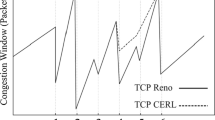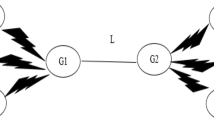Abstract
In this paper, we propose and verify a modified version of TCP Reno that we call TCP Congestion Control Enhancement for Random Loss (CERL). We compare the performance of TCP CERL, using simulations conducted in ns-2, to the following other TCP variants: TCP Reno, TCP NewReno, TCP Vegas, TCP WestwoodNR and TCP Veno. TCP CERL is a sender-side modification of TCP Reno. It improves the performance of TCP in wireless networks subject to random losses. It utilizes the RTT measurements made throughout the duration of the connection to estimate the queue length of the link, and then estimates the congestion status. By distinguishing random losses from congestion losses based on a dynamically set threshold value, TCP CERL successfully attacks the well-known performance degradation issue of TCP over channels subject to random losses. Unlike other TCP variants, TCP CERL doesn’t reduce the congestion window and slow start threshold when random loss is detected. It is very simple to implement, yet provides a significant throughput gain over the other TCP variants mentioned above. In single connection tests, TCP CERL achieved an 175, 153, 85, 64 and 88% throughput gain over TCP Reno, TCP NewReno, TCP Vegas, TCP WestwoodNR and TCP Veno, respectively. In tests with multiple coexisting connections, TCP CERL achieved an 211, 226, 123, 70 and 199% throughput improvement over TCP Reno, TCP NewReno, TCP Vegas, TCP WestwoodNR and TCP Veno, respectively.





















Similar content being viewed by others
Notes
In our explanation of Veno we have used symbols consistent with those used in our treatment of CERL.
We commented out the line of code which sets lastDecMaxSentSeqno=MaxSentSeqno.
Since the advertised window and router buffers are specified in units of packets in ns-2, we must divide the bandwidth-delay product by the packet size of 1460 bytes.
References
Allman, M., Paxson, V., & Stevens, W. (1999). TCP congestion control, RFC 2581, April 1999.
Kumar, A. (1998). Comparative performance analysis of versions of TCP in a local network with a lossy link. IEEE/ACM Transactions on Networking, 6(4), 485–498.
Lakshman, T. V., & Madhow, U. (1997). The performance of TCP/IP for networks with high bandwidth-delay products and random loss. IEEE/ACM Transaction on Networking, 5(3), 336–350.
Pentikousis, K. (2000). TCP in wired-cum-wireless environments. IEEE Communications Surveys & Tutorials, 3(4), 4th Quarter 2000.
Floyd, S., Henderson, T., & Gurtov, A. (2004). The NewReno modification to TCP’s fast recovery algorithm, RFC 3782, April 2004.
Brakmo, L. S., O’Malley, S. W., & Patterson, L. L. (1994). Vegas: New techniques for congestion detection and avoidance. In Proceedings of ACM SIGCOMM‘4, pp. 24–25, October 1994.
Balakrishnan, H., Padmanabhan, V. N., Seshan, S., & Katz, R. H. (1997). A comparison of mechanisms for improving TCP performance over wireless Links. IEEE/ACM Transactions on Networking, December 1997.
Casetti, C., Gerla, M., Mascolo, S., Sanadidi, M. Y., & Wang, R. (2002). TCP Westwood: End-to-end congestion control for wired/wireless networks. Wireless Networks, 8(5), 467–479.
Chi, C. L., Chengpeng, F., & Chang, L. S. (2001). Improvements achieved by SACK employing TCP Veno equilibrium-oriented mechanism over lossy networks. EUROCON.
Fu, C. P., & Liew, S. C. (2003). TCP Veno: TCP enhancement for transmission over wireless access networks. IEEE Journal on Selected Areas in Communications, 21(2), 216–228.
Pang, Q., Liew, S. C., Fu, C. P., Wang, W., & Li, V. O. K. (2003). Performance study of TCP Veno over WLAN and RED router. In Proceedings of Globecom.
Zhang, C. L., Fu, C. P., Yap, M.-T., Foh, C. H., Wong, K. K., Lau, C. T., & Lai, M. K. (2004). Dynamics comparison of TCP Veno and Reno. In Proceedings of Globecom.
Clark, D. (1988). The design philosophy of the DARPA Internet protocols. In Proceedings of SIGCOMM‘88 ACM Computer Communication Review, pp. 106–114.
Reed, D. (2000, April). The end of the end-to-end argument? [online]. Available: http://www.reed.com/dprframeweb/dprframe.asp?section=paper&fn=endofendtoend.html
Kempf, J., & Austein, R. (2004). The rise of the middle and the future of end-to-end: Reflections on the evolution of the Internet architecture, RFC 3724, March 2004.
Patel, P., Wetherall, D., Lepreau, J., & Whitaker, A. (2003). TCP meets mobile code. In Proceedings of the Ninth Workshop on Hot Topics in Operating Systems (HotOS IX), May 2003.
Mitzel, D. (2000). Overview of 2000 IAB wireless Internet working workshop. Internet Engineering Task Force (IETF), ser. Rep. RFC3002.
ns-2 network simulator. LBL, URL: http://www.isi.edu/nsnam/ns
Stevens, W. R. (1994). TCP/IP illustrated, vol. 1. Addison Wesley.
Wu, J., & El-Ocla, H. (2004). TCP congestion avoidance model with congestive loss. IEEE International Conference on Networks, November 2004.
Anderson, T., Shenker, S., Stoica, I., & Wetherall, D. (2002). Design guidelines for robust Internet protocols. HotNets-I, October 2002.
UCLA Computer Science Department (2002, March) TCP WESTWOOD – Modules for NS-2 [online]. Available: http://www.cs.ucla.edu/NRL/hpi/tcpw/tcpw_ns2/tcp-westwood-ns2.html
Allman M., & Falk, A. (1999). On the effective evaluation of TCP. ACM Computer Communications Review, 29(5), 59–70.
L’Ecuyer, P. (1999). Good parameters and implementations for combined multiple recursive random number generators. Operations Research, 47(1), 159–164.
Mo, J., La, R. J., Anantharam, V., & Warland, J. J. Analysis and comparison of TCP Reno Vegas. In Proc. INFOCOM 99, 3, pp. 1556–1563.
Hengartner, U., Bolliger, J., & Gross, T. (2000). TCP Vegas revisited. In Proc. INFOCOM 2000, pp. 1546–1555.
Mathis, M., Semke, J., & Mahdavi, J. (1997). The macroscopic behavior of TCP congestion avoidance algorithm. Computer Communications Review, 27(3), 67–82.
Padhye, J., Firoiu, V., Towsley, D. F., & Kurose, J. (2000). Modeling TCP Reno performance: A simple model and its empirical validation. IEEE/ACM Transactions on Networking, 8(2), 133–145.
Altman, E., Avrachenkov, K., & Barakat, C. (2000). A stochastic model of TCP/IP with stationary random losses. Communication Review, 30, 231–242.
Vardalis, D., & Tsaoussidis, V. (2002). Efficiency/Fairness tradeoffs in networks with wireless components and transient congestion. The Journal of Supercomputing, 281–296.
Acknowledgements
The author is grateful to Mr. Marshall Hahn, Mr. Jiang Wu, and Mr. Kevin Smeltzer for their support of this work. This work was supported in part by National Science and Engineering Research Council of Canada (NSERC) under Grant 250299-02.
Author information
Authors and Affiliations
Corresponding author
Rights and permissions
About this article
Cite this article
El-Ocla, H. TCP CERL: congestion control enhancement over wireless networks. Wireless Netw 16, 183–198 (2010). https://doi.org/10.1007/s11276-008-0123-4
Published:
Issue Date:
DOI: https://doi.org/10.1007/s11276-008-0123-4




